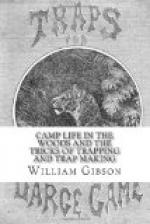[Page 256] During the night time, the tent or shanty often becomes swarmed with the winged pests, and their nocturnal assaults are proverbial for their pertinacity and severity. Their thirst for blood overcomes every other instinct, and pennyroyal often ceases to have any effect. Our Adirondack guide, in narrating his experience with these insect vampires, even says that on a certain night, becoming exasperated at their indomitable perseverance, and, getting tired of the monotonous occupation of spreading ointment, he arose, lit his candle, and drove the creatures out of the tent. He then buttoned up the opening, and retired to rest. A storm came up in the night, and so completely had his canvas been riddled by the bills of the mosquitoes, that the rain poured through his tent as through a sieve.
We have heard of the man who, when pursued by hungry mosquitoes, took refuge beneath a large chaldron, and, by the aid of a stone, clinched the blood-thirsty bills as they protruded in quest of his life-blood, until, by the united efforts of the winged captives, the chaldron was lifted and wafted out of sight, as if it were a feather.
One story is just as true as the other, and a summer in the Adirondack woods will tend to strengthen, rather than diminish, the belief in either.
The smoke of smouldering birch bark will effectually drive away the mosquitoes from the tents at night. This method is commonly known as “the smudge,” and is more fully described in another part of this work.
The smell of the smoke is often unpleasant at first, but it is always preferable to the insect bites.
Mosquitoes are not the only vampires which infest our wooded lands. The “punkeys” and “midgets” can outstrip them for voracity and the painful character of the wound which they inflict. The “punkey,” or “black-fly,” as it is called, is a small, black gnat, about the size of a garden ant, and the bite of the insect often results very seriously. The midget is a minute little creature, and is the most everlastingly sticky and exasperating pest in the catalogue of human torments. They fly in swarms of thousands, and go for their victim “en masse” and the face, hands and neck are soon covered as if with “hay seed.” They stick where they first light, and commence operations immediately. All endeavors to shake them off are fruitless, and their combined attacks are soon most painfully realized. Their bites produce great redness and swelling, and the itching is most intolerable. Happily for the woodsman, the “smudge” [Page 257] and pennyroyal ointment are effectual preventives against the attacks of both midgets and black flies, as well as mosquitoes; and no one who values his life or good looks should venture on a woodland excursion in the summer months without a supply of this latter commodity. In conclusion, we would remark that, to the mosquito the blood of the intemperate seems to have a special attraction, and anyone who wishes




